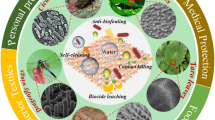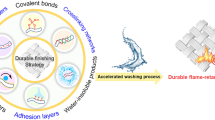Abstract
Cotton fabrics have been treated by sol–gel processes in order to produce an inorganic coating on fibres, able to modify their thermal conductivity under an irradiating flow. To this aim, fabric specimens with different silica content have been tested following the ISO 6942 standard in order to establish the effect of the coating on coupled heat and moisture transfer through the cotton fibres. The collected results have been compared with those obtained by an optimized method using a cone calorimeter as the heating source. By this latter approach, it has been demonstrated that sol–gel cotton treated fabrics with high moisture uptake possess a significantly lower thermal conductivity with respect to cotton alone.




Similar content being viewed by others
References
Bouddour A, Auriault JL, Mhamdi-Alaoui M. Heat and mass transfer in wet porous media in presence of evaporation-condensation. Int J Heat Mass Transf. 1998;41:2263–77.
Spencer-Smith JL. The physical basis of clothing comfort, part 2: heat and transfer through dry clothing assemblies. Cloth Res J. 1977;5:3–17.
Henry PSH. Diffusion of moisture and heat through textiles. Discuss Faraday Soc. 1948;3:243–57.
Gibson PW, Charmchi M. Modeling convection/diffusion processes in porous textiles with inclusion of humidity-dependent air permeability. Int Comm Heat Mass Transf. 1997;24:709–24.
Zhu Q, Li Y. Effects of pore size distribution and fiber diameter on the coupled heat and liquid transfer in porous textiles. Int J Heat Mass Transf. 2003;46:11–5099.
Wang Z, Li Y, Zhu QY, Luo ZX. Radiation and conduction heat transfer coupled with liquid water transfer, moisture sorption, and condensation in porous polymer materials. J Appl Polym Sci. 2003;89:2780–90.
Cheng X, Fan J. Simulation of heat and moisture transfer with phase change and mobile condensates in fibrous insulation. Int J Therm Sci. 2004;43:665–76.
Fan J, Cheng X, Wen X, Sun W. An improved model of heat and moisture transfer with phase change and mobile condensates in fibrous insulation and comparison with experimental results. Int J Heat Mass Transf. 2004;47:2343–52.
Fan J, Cheng X, Chen YS. An experimental investigation of moisture absorption and condensation in fibrous insulations under low temperature. Exp Therm Fluid Sci. 2003;27:723–9.
Zhu F, Li K. Numerical modeling of heat and moisture through wet cotton fabric using the method of chemical thermodynamic law under simulated fire. Fire Technol. 2011;47:801–19.
Zeronian SH, Ellison MS, Alger K. Influence of moisture on the flame retardance of textile fabrics. J Appl Polym Sci. 1980;25:1311–22.
Gasperin M, Juricic D, Musizza B, Mekjavic I. A model-based approach to the evaluation of flame-protective garments. ISA Trans. 2008;47:198–210.
ISO 6942. Protective clothing-protection against heat and fire-method of test: evaluation of materials and material assemblies when exposed to a source of radiant heat; 2002.
Alongi J, Ciobanu M, Malucelli G. Cotton fabrics treated with hybrid organic–inorganic coatings obtained through dual-cure processes. Cellulose. 2011;18:1335–8.
Alongi J, Ciobanu M, Malucelli G. Sol–gel treatments for enhancing fire stability of cotton fabrics: optimization of the process and evaluation of durability. Cellulose. 2011;18:167–77.
Alongi J, Ciobanu M, Malucelli G. Novel flame retardant finishing systems for cotton fabrics based on phosphorus-containing compounds and silica derived from sol–gel processes. Carbohydr Polym. 2011;85:599–608.
Alongi J, Ciobanu M, Carosio F, Tata J, Malucelli G. Thermal stability and flame retardancy of polyester, cotton and relative blend textile fabrics treated by sol–gel process. J Appl Polym Sci. 2011;119:1961–9.
Alongi J, Ciobanu M, Malucelli G. Sol–gel treatments on cotton fabrics for improving thermal and flame stability: effect of the structure of the alkoxysilane precursor. Carbohydr Polym. 2012;87:627–35.
Alongi J, Ciobanu M, Malucelli G. Thermal stability, flame retardancy and mechanical properties of cotton fabrics treated with inorganic coatings synthesized through sol–gel processes. Carbohydr Polym. 2012;87:2093–9.
Alongi J, Colleoni C, Rosace G, Malucelli G. Thermal and fire stability of cotton fabrics coated with hybrid phosphorus-doped silica films. J Therm Anal Calorim. 2011. doi:10.1007/s10973-011-2142-0.
Acknowledgements
The authors would like to thank Mr. Fabio Cuttica and Dr. Mihaela Ciobanu for the technical support in preparing the sol–gel treated fabrics.
Author information
Authors and Affiliations
Corresponding author
Rights and permissions
About this article
Cite this article
Alongi, J., Malucelli, G. Heat and moisture transfer in sol–gel treated cotton fabrics. J Therm Anal Calorim 111, 459–465 (2013). https://doi.org/10.1007/s10973-012-2462-8
Received:
Accepted:
Published:
Issue Date:
DOI: https://doi.org/10.1007/s10973-012-2462-8




